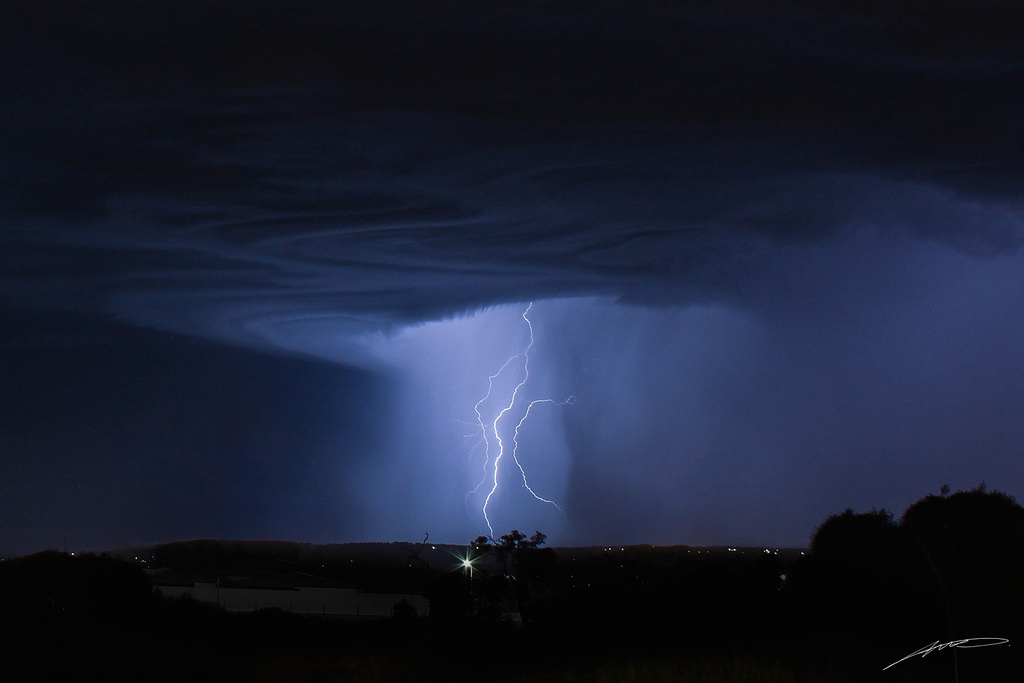Inducing rain and lightning with high-energy laser beams

Researchers at the University of Central Florida’s College of Optics & Photonics and the University of Arizona are developing a new technique to aim a high-energy laser beam into clouds to make it rain or trigger lightning.
They are surrounding one beam with a second one to act as an energy reservoir, sustaining the central beam to greater distances than previously possible. The secondary “dress” beam refuels and helps prevent the dissipation of the high-intensity primary beam, which on its own would break down quickly.
Water condensation and lightning activity in clouds are linked to large amounts of static charged particles. Stimulating those particles with the right kind of laser holds the key to possibly one day summoning a shower when and where it is needed.
Lasers can already travel great distances but “when a laser beam becomes intense enough, it behaves differently than usual – it collapses inward on itself,” said Matthew Mills, a graduate student in the Center for Research and Education in Optics and Lasers (CREOL). “The collapse becomes so intense that electrons in the air’s oxygen and nitrogen are ripped off creating plasma – basically a soup of electrons.”
At that point, the plasma immediately tries to spread the beam back out, causing a struggle between the spreading and collapsing of an ultra-short laser pulse. This struggle is called filamentation, and creates a filament or “light string” that only propagates for a while until the properties of air make the beam disperse.
“Because a filament creates excited electrons in its wake as it moves, it artificially seeds the conditions necessary for rain and lightning to occur,” Mills said. Other researchers have caused “electrical events” in clouds, but not lightning strikes.
But how do you get close enough to direct the beam into the cloud without being blasted to smithereens by lightning?
“What would be nice is to have a sneaky way which allows us to produce an arbitrary long ‘filament extension cable.’ It turns out that if you wrap a large, low intensity, doughnut-like ‘dress’ beam around the filament and slowly move it inward, you can provide this arbitrary extension,” Mills said.
“Since we have control over the length of a filament with our method, one could seed the conditions needed for a rainstorm from afar. Ultimately, you could artificially control the rain and lightning over a large expanse with such ideas.”
So far, Mills and fellow graduate student Ali Miri have been able to extend the pulse from 25.4 cm (10 inches) to about 2 m (7 feet). And they’re working to extend the filament even farther.
“This work could ultimately lead to ultra-long optically induced filaments or plasma channels that are otherwise impossible to establish under normal conditions,” said professor Demetrios Christodoulides, who is working with the graduate students on the project.
“In principle such dressed filaments could propagate for more than 50 meters or so, thus enabling a number of applications. This family of optical filaments may one day be used to selectively guide microwave signals along very long plasma channels, perhaps for hundreds of meters.”
Other possible uses of this technique could be used in long-distance sensors and spectrometers to identify chemical makeup. Development of the technology was supported by a $7.5 million grant from the Department of Defense.
Source: University of Central Florida
Reference:
- "Externally refuelled optical filaments" – Maik Scheller, Matthew S. Mills, Mohammad-Ali Miri, Weibo Cheng, Jerome V. Moloney, Miroslav Kolesik, Pavel Polynkin & Demetrios N. Christodoulides – Nature Photonics 8, 297–301 (2014) doi:10.1038/nphoton.2014.47
Featured image: Lightning Hunters by http://www.flickr.com/photos/31433144@N08/13379058795

Hope they're studying how to turn the rain off, too.
…and where does the Department of Defense get their funds to fund these grants? I wonder…
Also, when are we going to learn to stop screwing with mother nature. Playing God will backfire in the end, but who who receive the reward?
Kind of disturbing because it sounds so similar to HAARP technology which can be used to induce earthquakes. The fact that the research is funded by the department of defense should make people wary.